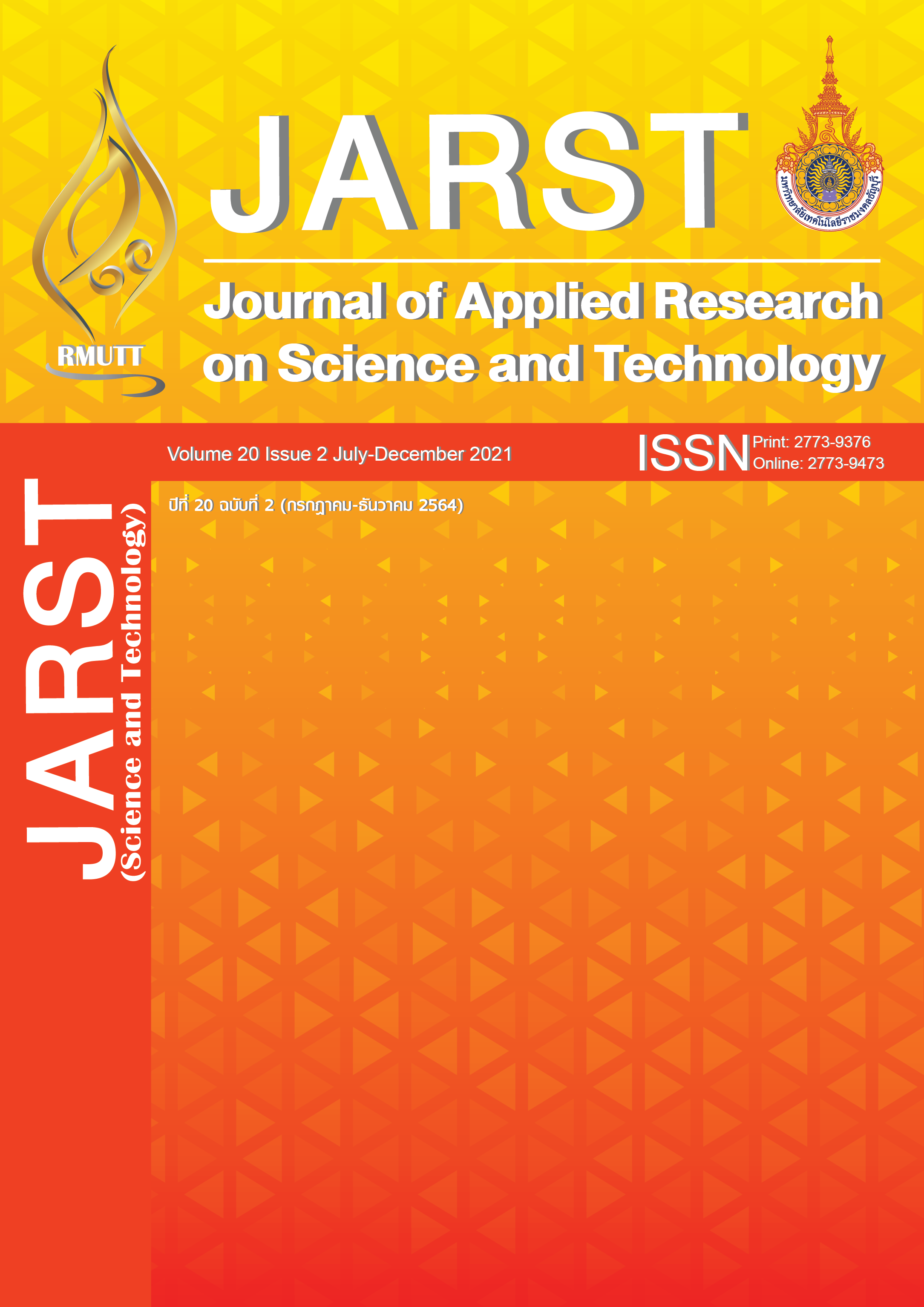Effect of Concentrated Chaya (Cnidoscolus chayamansa) Vegetable Juice on Quality of Reduced Sugar Roselle Jam
Main Article Content
Abstract
The Chaya leaves have been found to be an important source of protein, β-carotene, vitamins, ascorbic acid, calcium, potassium and iron. It is rich in antioxidant and phenolic compound. This study aims to investigate the effect of concentrated Chaya vegetable juice (0 (control; C2), 5, 10, 15 and 20 g on quality of Roselle jam (without pectin) and compared with control (C1; Roselle jam with pectin). Roselle Jam reduced- sugar with concentrated Chaya vegetable juice was evaluated for color, pH, total soluble solid, titratable acidity, stability and sensory properties. Roselle jam reduced-sugar with concentrated Chaya vegetable juice was less dark-red color than C2. The pH of C1 was more than jam from C2, 5, 10, 15 and 20 g of concentrated Chaya vegetable juice. Jam samples showed pH ranging between 2.55-2.59. While, Roselle jam added with concentrated Chaya vegetable juice, C1 and C2 were not significantly different in total soluble solid. The total soluble solid of all Roselle jam ranged between 66 and 68°Brix. The titratable acidity increased with increase in concentrated Chaya vegetable juice. Addition of 10 g concentrated Chaya vegetable juice into Roselle jam showed the highest stability. The sensory score of color, odor, taste, stability of jam and overall acceptance results indicated that Roselle jam processed from 15 and 20 g of concentrated Chaya vegetable juice were generally high. However, the results showed that Roselle jams prepared from concentrated Chaya vegetable juice are still acceptable. Therefore, concentrated Chaya vegetable juice could potentially be used for replacement of the sugar in the formulated jam.
Article Details

This work is licensed under a Creative Commons Attribution-NonCommercial-NoDerivatives 4.0 International License.
References
Tanthawanich O. Mexican kale, easy to grow, easy to eat, suitable for urban people with limited space [Internet]. Bangkok: Technologychaoban; 2019 [cited 2019 Apr 09]. Availability from: https://shorturl.asia/vhlqF. Thai.
Kulathuran PK, Narayanan N, Chidambaranathan N, Jegan N. Phytochemical analysis of leaf extract of Cnidoscolus chayamansa McVaugh. Int J Pharmacogn Phytochem Res. 2014;6(4):741-5.
Kuti JO, Torres ES. Potential nutritional and health benefits of tree spinach. In: J. Janick, editor. Progress in new crops. VA: ASHS Press Arlington; 1996: p. 516-20.
Thai community product standard. Jam. [Internet]. Bangkok: Thai industrial standards institute; 2019 [cited 2019 Apr 09]. Availability from: http:// tcps.tisi.go.th/pub/tcps342_47.pdf. Thai.
Wanniyom V. Development of passion fruit jam using passion fruit rind [master’s thesis]. Chiang Mai: Chiang Mai University; 2009. Thai.
Ramrak M. Production of jam, jelly and marmalade [Internet]. KU-eMagazine; 2018 [cited 2018 Aug 06]. Availability from: http://www.ku.ac.th/emagazine/december43/agri/jam.html. Thai.
Sinthawalai S. Food Theory, Volume 1; Principles of Cooking. 4th ed, Bangkok: Kasetsart University; 1982. Thai.
Jaisan P, Klinhom J, Taimpakdee A. The test of pectin extracted from passion fruit peed in producing jam. Chiang Mai: Chiang Mai University; 1998. Thai.
Tornoda A, Tsuji A, Yoneyarna Y. Involvement of superoxide anion in the reaction mechanism of haernoglobin oxidation by nitrite. Journal of Biochem. 1989;193:169-79.
Toemwong N. [Total antioxidant, phenolic compounds and vitamin C of vegetables and herbs]. Advanced Science journal. 2008;8(1):41-8. Thai.
Saveski A, Stamatovska V, Pavlova V, Kalevska T, Spirovska VR. Sensory analysis of raspberry jam with different sweeteners. In: Food science, engineering and technologies-2015; 2015 Oct; Scientific works of University of Food Technologies, Plovdiv, Bulgaria. p. 294-97.
Vilela A, Matos S, Abraão AS, Lemos AM, Nunes F. Sucrose replacement by sweeteners in strawberry, raspberry and cherry jams: effect on the textural characteristics and sensorial profile - a chemometric approach. J Food Process. 2015;2015:1-14.
Santanu B, Shivhare US. Rheological, textural, microstructural, and sensory properties of sorbitol-substituted mango jam. Food Bioprocess Technol. 2013;6:1401-13.
Babalola JO, Alabi OO. Effect of processing methods on nutritional composition, phytochemicals, and anti-nutrient properties of chaya leaf (Cnidoscolus aconitifolius). Afr J Food Sci. 2015;9(12):560-5.
Nausheen H, Siddiqui IA, Omar MT, Sana M, Zafar AM. Influence of pectin concentrations on physicochemical and sensory qualities of jams. J Pharm Pharm Sci. 2015;4(6):68-77.
Lichanporn I, Nanthachai N, Tanganurat P, Singkham A, Kromnongpai P. [Effect of pectin from watermelon rind on quality of roselle (Hibiscus sabdariffa L.) jam]. Research Journal Rajamangala University of Technology Thanyaburi. 2020;19(1):64-73. Thai.
AOAC. Official methods of analysis. 17th ed. Washington, D.C.: The Association of Official Analytical Chemists; 2000.
Hussein RM, Shahein YE, Hakim AEE, Awad HM. Biochemical and molecular characterization of three colored types of roselle (Hibiscus sabdariffa L.). Am J Sci. 2010;6:726-33.
Sriboonthai C. Morphological characterization and secondary metabolites of roselle (Hibiscus sabdariffa L.) [master’s thesis]. Pathum Thani: Thammasat University; 2016. Thai.
Kuri-Garcia A, Chavez-Servin JL, Guzman-Maldonado SH. Phenolic profile and antioxidant capacity of Cnidoscolus chayamansa and Cnidoscolus aconitifolius: A review. J Med Plants Res. 2017;11(45):713-27.
Ngampeerapong N. Development of roselle jam product with reduced sugar [master’s thesis]. Bangkok: Kasetsart University; 2014. Thai.
Fraeye I, Duvetter T, Doungla E, Loeyand AV, Hendrickx M. Fine-tuning the properties of pectin-calcium gels by control of pectin fine structure, gel composition and environmental. Trends Food Sci Tech. 2010;21:219-28.
Silapanapaporn O. Development of pineapple jam to meet quality standard for industry [master’s thesis]. Bangkok: Kasetsart University; 1990. Thai.

